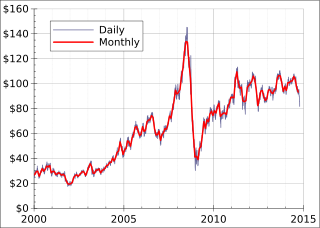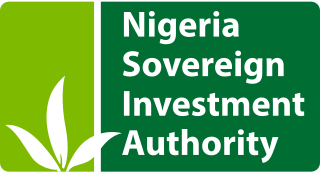Related Research Articles
The Alaska Permanent Fund (APF) is a constitutionally established permanent fund managed by a state-owned corporation, the Alaska Permanent Fund Corporation (APFC). It was established in Alaska in 1976 by Article 9, Section 15 of the Alaska State Constitution under Governor Jay Hammond and Attorney General Avrum Gross. From February 1976 until April 1980, the Department of Revenue Treasury Division managed the state's Permanent Fund assets, until, in 1980, the Alaska State Legislature created the APFC.
The Government Pension Fund of Norway comprises two entirely separate sovereign wealth funds owned by the government of Norway.
An institutional investor is an entity that pools money to purchase securities, real property, and other investment assets or originate loans. Institutional investors include commercial banks, central banks, credit unions, government-linked companies, insurers, pension funds, sovereign wealth funds, charities, hedge funds, real estate investment trusts, investment advisors, endowments, and mutual funds. Operating companies which invest excess capital in these types of assets may also be included in the term. Activist institutional investors may also influence corporate governance by exercising voting rights in their investments. In 2019, the world's top 500 asset managers collectively managed $104.4 trillion in Assets under Management (AuM).

The Permanent University Fund (PUF) is a sovereign wealth fund created by the State of Texas to fund public higher education within the state. A portion of the returns from the PUF are annually directed towards the Available University Fund (AUF), which distributes the funds according to provisions set forth by the 1876 Texas Constitution, subsequent constitutional amendments, and the board of regents of the Texas A&M University System and University of Texas System. The PUF provides extra funds, above monies from tax revenues, to the UT System and the Texas A&M System which collectively have approximately 50 percent of state public university students. The PUF does not provide any funding to other public Universities in the State of Texas.

The Abu Dhabi Investment Authority is a sovereign wealth fund owned by the Emirate of Abu Dhabi in the United Arab Emirates, founded to invest funds on behalf of the Government of Abu Dhabi. It manages the emirate's excess oil reserves and is estimated to manage $853 billion. ADIA is one of the largest sovereign wealth funds in the world.
The Future Fund is an independently managed sovereign wealth fund established in 2006 to strengthen the Australian Government's long-term financial position by making provision for unfunded superannuation liabilities for politicians and other public servants that will become payable during a period when an ageing population is likely to place significant pressure on the Commonwealth's finances. As of December 31 2023, the fund has $272.3 billion in assets under management.

The Stabilization fund of the Russian Federation was a sovereign wealth fund established based on a resolution of the Government of Russia on 1 January 2004, as a part of the federal budget to balance the federal budget at the time of when oil price falls below a cut-off price, currently set at US$27 per barrel.

A sovereign wealth fund (SWF), sovereign investment fund, or social wealth fund is a state-owned investment fund that invests in real and financial assets such as stocks, bonds, real estate, precious metals, or in alternative investments such as private equity fund or hedge funds. Sovereign wealth funds invest globally. Most SWFs are funded by revenues from commodity exports or from foreign-exchange reserves held by the central bank.

China Investment Corporation is a sovereign wealth fund that manages part of China's foreign exchange reserves. China's largest sovereign fund, CIC was established in 2007 with about US$200 billion of assets under management, a number that grew to US$1,200 billion in 2021 and US$1,350 billion in 2023.

The 75th Oregon Legislative Assembly convened beginning on January 12, 2009, for its biennial regular session. All of the 60 seats in the House of Representatives and half of the 30 seats in the State Senate were up for election in 2008; the general election for those seats took place on November 4.
The Board of Commissioners of Public Lands, otherwise known as BCPL, is a state agency responsible for investing Wisconsin's school trust funds in support of public education, for managing the state's remaining school trust lands, and for maintaining an extensive archive of land records. The board was established by Article X, Sections 7 and 8 of the Wisconsin Constitution, ratified in 1848, making it Wisconsin's oldest extant state agency.
The Texas Permanent School Fund is a sovereign wealth fund which serves to provide revenues for funding of public primary and secondary education in the US state of Texas. Its assets include many publicly owned lands within Texas and various other investments; as of the end of fiscal 2020, the fund had an endowment of $48.3 billion. The fund is distinct from the Permanent University Fund, which funds most institutions in the University of Texas System and the Texas A&M University System, but no other public universities or schools in the state.
The Alabama Trust Fund (ATF) is the wealth fund of the U.S. state of Alabama and was established in 1985 in response to a major offshore natural gas discovery in 1978. The fund is funded by royalty payments that are received each month from oil and gas companies and its assets total around $2.5 billion. The fund is invested in both fixed income and equities and is under the jurisdiction of the treasury of the State of Alabama. The fund is managed by external managers chosen by the board of trustees. The ATF’s nine-member board is chaired by Governor Kay Ivey.

The Nigeria Sovereign Investment Authority is a Nigerian establishment which manages the Nigeria sovereign wealth fund, into which the surplus income produced from Nigeria's excess oil reserves is deposited. This sovereign wealth fund was founded for the purpose of managing and investing these funds on behalf of the government of Nigeria. The fund was established by the Nigeria Sovereign Investment Authority Act 2011, signed in May 2011, and commenced operations in October 2012. It is intended to invest the savings gained on the difference between the budgeted and actual market prices for oil to earn returns that would benefit future generations of Nigerians. The fund was allocated an initial US$1 billion in seed capital, and, an additional $0.60billion has been contributed to date by the current administration. In October 2023, the fund has US$2.3 billion in assets under management.

The Fundo Soberano de Angola is the sovereign wealth fund of Angola. It is a member of the International Forum of Sovereign Wealth Funds, and therefore has signed up to the Santiago Principles on best practice in managing sovereign wealth funds. The FSDEA is meant to play an important role in promoting Angola’s social and economic development and generating wealth for its people. The fund was rated by the SWFI in February 2015 with a ranking of 8 out of 10.

The Public Investment Fund is the sovereign wealth fund of Saudi Arabia. It is among the largest sovereign wealth funds in the world with total estimated assets of US$925 billion. It was created in 1971 for the purpose of investing funds on behalf of the Government of Saudi Arabia. The wealth fund is controlled by Crown Prince Mohammed bin Salman, Saudi Arabia's de facto ruler since 2015.
The Indonesia Investment Authority (INA) is the sovereign wealth fund of Indonesia. The INA was founded by the Indonesian Government in 2021 to strengthen the country's economy by diversifying into new asset classes. INA was launched in February, 2021, with a target of managing $24.5 billion of assets. Unlike sovereign wealth funds of other countries which manage excess oil revenues or foreign exchange reserves, the INA seeks foreign funds as co-investors to finance the country's economic development.
References
- ↑ "Land Grant Permanent Fund". New Mexico State Investment Council. Retrieved 2024-04-12.
- ↑ Williams, Amy (Summer 2008). "New Mexico's Land Grant and Severance Tax Permanent Funds: Renewable Wealth from Non-Renewable Resources". Natural Resources Journal. 48 (3): 719–743 – via JSTOR.
- ↑ MossAdams (June 30, 2023). "Report of Independent Auditors and Financial Statements with Supplementary Information". SIC Annual Audit Reports. Retrieved April 11, 2024.
- ↑ Chief, Dan Boyd / Journal Capitol Bureau (2023-04-25). "NM permanent funds are more flush than ever — and still growing — amid revenue windfall". Albuquerque Journal. Retrieved 2024-04-12.
- ↑ Prokop, Danielle (2023-12-22). "N.M. State Land Office raises record revenues • Source New Mexico". Source New Mexico. Retrieved 2024-04-12.
- ↑ Rubel, Walt (2020-12-26). "The History Of New Mexico's Permanent Fund". KRWG Public Media. Retrieved 2024-04-12.
- 1 2 3 "Council Members". New Mexico State Investment Council. Retrieved 2024-04-12.
- ↑ "History". New Mexico State Investment Council. Retrieved 2024-04-12.
- ↑ "NAEP Reading: State Achievement-Level Results". www.nationsreportcard.gov. Retrieved 2024-04-12.
- ↑ Invest In Kids Now. "How the Land Grant Permanent Fund Works" (PDF). Invest in Kids Now. Retrieved 11 April 2024.
- ↑ "Permanent Funding for Early Childhood". Invest in Kids Now!. Retrieved 2024-04-12.
- ↑ "The New Mexico Secretary of State's 2022 General Election Voter Guide: Proposed Constitutional Amendments, General Obligation Bonds & General Information About Voting in New Mexico" (PDF). October 2022. Retrieved 11 April 2024.
- ↑ "New Mexico Constitutional Amendment 1, Land Grant Permanent Fund Distribution for Early Childhood Education Amendment (2022)". Ballotpedia. Retrieved 2024-04-12.
- ↑ Candelaria, Esteban (2022-11-08). "Voters approve amendment to spend more money on early childhood education". Albuquerque Journal. Retrieved 2024-04-12.